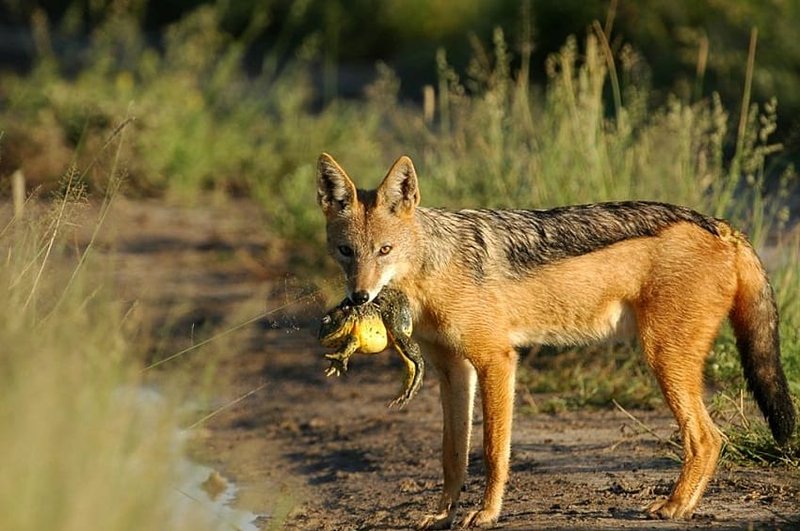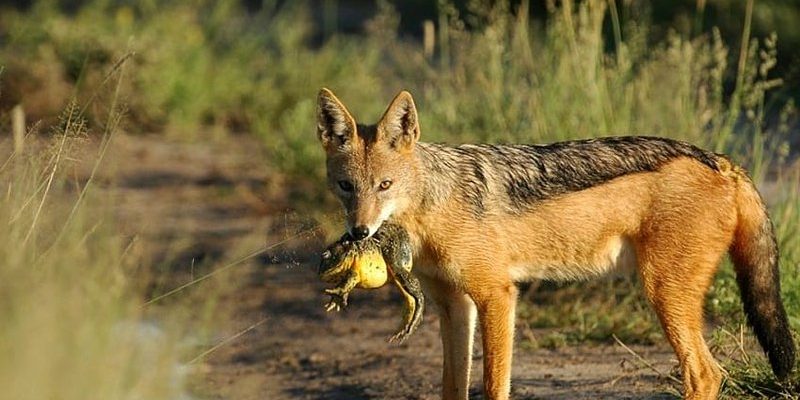
Let’s take a closer look at the habitat and distribution of black-backed jackals. These small but cunning animals thrive in a range of environments, from arid deserts to grassy plains. Understanding their habitats not only adds to our appreciation of nature but also helps with their conservation. So, let’s dive in!
What Are Black-Backed Jackals?
Before we explore their habitats, it’s important to know a bit about black-backed jackals themselves. These jackals have a striking appearance with a sandy-colored body and a distinct black stripe along their back. They are generally about 20-24 inches tall at the shoulder, making them smaller than a wolf but larger than a fox. Think of them as the clever cousins of domestic dogs, with a similar face but a much wilder lifestyle.
Black-backed jackals are known for their adaptability. They are part of the Canidae family, which includes foxes, wolves, and domestic dogs. Their behavior is fascinating, as they often scavenge for food but can also hunt small animals. This mix of eating habits helps them survive in various environments.
The Geographic Range of Black-Backed Jackals
So, where exactly do black-backed jackals live? Their range primarily spans southern and eastern Africa. They can be found in countries like South Africa, Namibia, Botswana, and Tanzania. Imagine tracing a colorful path across your map of Africa, with different colors representing the various habitats these jackals occupy.
In these regions, they thrive in a variety of settings. Their adaptability helps them succeed in different climates, including both savannas and scrublands. Whether they’re scavenging in the grasslands or hunting in more rugged terrains, black-backed jackals are often seen in places where there is plenty of cover and access to food.
Preferred Habitats: Savannas and Grasslands
One of the most common habitats for black-backed jackals is the savanna. This environment is characterized by open grassland dotted with trees. Think of a picturesque landscape, where the sun sets over golden grasses swaying in the breeze. Black-backed jackals blend into this setting beautifully, using the tall grass as cover while hunting or looking for scavenging opportunities.
In these savannas, jackals tend to establish territorial boundaries. They’re known for their vocalizations, which include a mix of barks and howls. This communication helps them scare off competitors and locate each other when necessary. The open space allows them to roam and hunt, making it an ideal habitat for these social animals.
Deserts and Scrublands: Unexpected Homes
You might be surprised to learn that black-backed jackals can also inhabit deserts and scrublands. Areas like the Kalahari Desert might not seem like a haven for wildlife at first glance. However, the hardy jackals have adapted well to the harsh conditions. They can survive on very little water and have a diet that allows them to thrive where other animals struggle.
In these arid regions, they often hunt small mammals, birds, and even insects. It’s a bit like playing a game of hide and seek with nature; they have to be clever and resourceful to find food and stay hydrated. Their ability to adapt to these harsh environments showcases how resilient they truly are.
Urban Encounters: Jackals in Human Habitats
As cities expand, black-backed jackals are starting to venture closer to human settlements. You might be wondering, how do these jackals adapt to urban life? Well, surprisingly well! In some regions, they have started to scavenge food from garbage and farms. It’s a bit like an animal version of a city slicker, learning to navigate the hustle and bustle of human activity.
While this can create conflicts between people and jackals, it also highlights their adaptability. In some cases, they even help control populations of rodents or pests, acting as nature’s cleanup crew. However, this can create tension, especially if jackals are perceived as a threat to livestock.
Conservation Status and Habitats
As we learn about the habitats of black-backed jackals, it’s crucial to touch on their conservation status. Currently, these animals are classified as Least Concern by the IUCN. This means they aren’t facing immediate threats, but that doesn’t mean we should overlook them. Habitat loss and human encroachment can still pose risks to their populations.
Preserving their natural habitats is essential for ensuring they continue to thrive. This involves protecting the savannas, grasslands, and desert areas they rely on. Additionally, educating communities about the role of black-backed jackals in the ecosystem can help foster coexistence.
The Importance of Black-Backed Jackals in Ecosystems
So, why should we care about where black-backed jackals live? These creatures play an important role in their ecosystems. They act as both predators and scavengers, helping to maintain balance in their environments. By hunting small rodents and scavenging carrion, they help control populations of other animals, preventing overpopulation and disease spread.
Imagine a delicate web of life where every strand matters. Black-backed jackals are an integral part of this web. By understanding their habitats and distribution, we can better appreciate how interconnected nature is. It’s a reminder that even small animals can have a significant impact on the world around them.
In summary, black-backed jackals are adaptable creatures that can thrive in a variety of habitats, from stunning savannas to rugged deserts. Their ability to navigate both natural and urban environments showcases their resilience and intelligence. By understanding where they live and why it matters, we can take steps to support their populations and protect their habitats.
Next time you hear a jackal’s howl or see an image of one in the wild, take a moment to appreciate the unique life they lead. Remember, they’re not just surviving; they’re playing essential roles in maintaining the balance of their ecosystems. By respecting these remarkable animals, we contribute to the rich tapestry of life on our planet.

